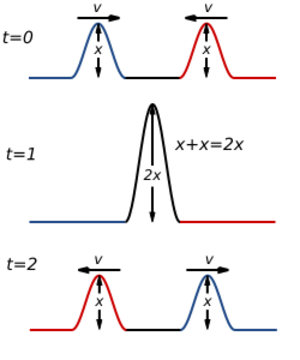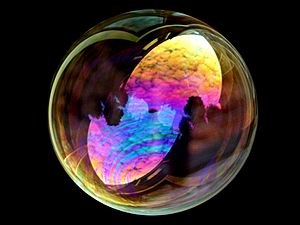Interference facts for kids
In physics, interference is what happens when two or more waves meet in the same place. Imagine dropping two rocks into a pond at the same time. The ripples (waves) from each rock spread out and eventually bump into each other. When they meet, they combine their effects.
Sometimes, the highest part of one wave (called a peak or crest) meets the highest part of another wave. When this happens, they join together to make an even taller wave. This is like two people pushing a car in the same direction – they make it move faster. This is called constructive interference.
Other times, the peak of one wave might meet the lowest part of another wave (called a trough). When this happens, they can cancel each other out, making the water flat. This is like two people pushing a car with equal strength from opposite directions – the car doesn't move. This is called destructive interference.
Contents
What is Constructive Interference?
Constructive interference happens when waves meet up and are "in phase." This means their peaks and troughs line up perfectly. When this occurs, the waves add their strengths together. The combined wave becomes much bigger or stronger than any of the individual waves were on their own.
Think of it like this:
- Time 0: One wave's peak is moving from the left, and another wave's peak is moving from the right.
- Time 1: The two wave peaks meet exactly in the middle. They combine to form a single, much taller peak.
- Time 2: The waves continue moving past each other. They separate and go back to their original heights as if nothing happened.
What is Destructive Interference?
Destructive interference happens when waves meet up and are "out of phase." This means the peak of one wave lines up with the trough (bottom) of another wave. When this happens, the waves subtract from each other's strength. The combined wave becomes smaller, or they might even cancel each other out completely, making the surface flat.
Here's how it works:
- Time 0: A wave peak is moving in from the left, and a wave trough is moving in from the right.
- Time 1: The two waves meet in the middle. The peak of one wave fills in the trough of the other, making the surface flat.
- Time 2: The waves continue moving past each other. They separate and reappear at their original shapes and sizes.
Examples of Interference in Everyday Life
Interference is all around us! Here are a few cool examples:
Oil Slicks and Soap Bubbles
After it rains, you might see colorful patterns on puddles where a little oil has spilled. You can also see amazing colors on a soap bubble. These colors appear because of interference.
Light from the sun hits the thin layer of oil or the soap bubble. Some of the light bounces off the very top surface. Other light goes through the oil or soap film and bounces off the bottom surface. These two reflected light waves then meet back in the air. Because the oil or soap film is super thin and has slightly different thicknesses, the light waves interfere. Some colors add up (constructive interference), making them bright, while others cancel out (destructive interference), making them disappear. This creates the beautiful rainbow patterns you see!
Noise-Canceling Headphones
Noise-canceling headphones use destructive interference to block out sounds from your surroundings. These headphones have tiny microphones that listen to the noise around you. Then, they create a new sound wave that is exactly opposite to the incoming noise. When this "anti-noise" wave meets the actual noise wave, they cancel each other out, making your listening experience much quieter!
Newton's Rings
When two very smooth pieces of glass are pressed together, you might see colorful rings appear. These are called "Newton's rings." They happen because there's a tiny, changing gap between the two glass surfaces. Light waves bounce off the top and bottom surfaces of this small air gap and interfere, creating the ring patterns.
How Scientists Study Light Interference
Scientists use special setups to study how light waves interfere. One common way is to place a curved piece of glass on top of a flat piece of glass. The distance between the two pieces changes as you move away from the center.
When light shines on this setup, some light reflects off the top surface of the curved glass, and some reflects off the top surface of the flat glass (after passing through the air gap). These two reflected light beams then meet. If they are "in phase" (their peaks line up), you see a bright spot. If they are "out of phase" (a peak meets a trough), they cancel out, and you see a dark spot. This creates a pattern of bright and dark rings or lines, helping scientists understand how light behaves as a wave.
See also
 In Spanish: Interferencia (desambiguación) para niños
In Spanish: Interferencia (desambiguación) para niños









